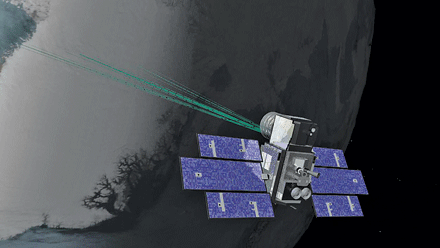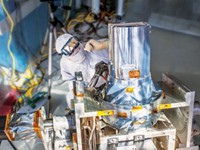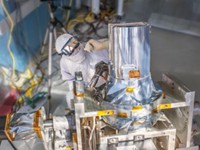Advertisement
Grab your lab coat. Let's get started
Welcome!
Welcome!
Create an account below to get 6 C&EN articles per month, receive newsletters and more - all free.
It seems this is your first time logging in online. Please enter the following information to continue.
As an ACS member you automatically get access to this site. All we need is few more details to create your reading experience.
Not you? Sign in with a different account.
Not you? Sign in with a different account.
ERROR 1
ERROR 1
ERROR 2
ERROR 2
ERROR 2
ERROR 2
ERROR 2
Password and Confirm password must match.
If you have an ACS member number, please enter it here so we can link this account to your membership. (optional)
ERROR 2
ACS values your privacy. By submitting your information, you are gaining access to C&EN and subscribing to our weekly newsletter. We use the information you provide to make your reading experience better, and we will never sell your data to third party members.
Environment
NASA Is Late On Climate Missions
Earth Science Programs are in limbo, awaiting Congress’ action on the 2011 budget
by David Pittman
December 20, 2010
| A version of this story appeared in
Volume 88, Issue 51

Further delays could hit several National Aeronautics & Space Administration research missions—important in advancing climate observation and already years in waiting—because of how Congress is handling passage of the 2011 budget.
The projects would cost roughly $1.5 billion and benefit NASA, the National Oceanic & Atmospheric Administration (NOAA), and the U.S. Geological Survey. They would measure solar radiation, soil moisture, and ice-sheet thickness, among other things, to provide researchers a deeper understanding of changes in climate and the atmosphere.
A 2007 National Research Council decadal survey of earth sciences highlighted the importance of these missions. A 19-member committee urged NASA to focus on 15 high-priority climate-observing missions and to start the four most important ones, dubbed “Tier 1,” as early as 2010. Even though NASA requested the NRC review, the space agency has yet to move beyond the design phase, and earlier this year, it delayed the scheduled launch of the first of the four Tier 1 missions to 2014.
“Perhaps our committee’s recommendations were too optimistic in terms of the schedule,” says Richard A. Anthes, president of the University Corporation for Atmospheric Research in Boulder, Colo., and cochairman of the NRC committee that issued the 2007 study. He attributes the delay in mission starts to lack of congressional funding. The report assumed that NASA had the resources to begin the missions and that everything would go smoothly, he says. “NASA, at the time in 2007, did not have enough money to implement these missions on the schedule that we recommended.”
Scott Pace, director of the Space Policy Institute at George Washington University and associate NASA administrator for program analysis and evaluation in 2007, says the space agency took the recommendations seriously. But “programming them into the NASA budget is an agency responsibility,” he adds, “and that depends on what funding NASA is authorized and appropriated by Congress.”
The Tier 1 missions do have the support of President Barack Obama, who provided funding in his fiscal 2011 budget request to meet an initial launch date of 2014 for one of the missions and for the rest to be operational by 2017. But Congress is still ironing out federal funding for fiscal 2011, which started on Oct. 1. As C&EN went to press, Congress was still working on budget legislation that would fund agencies in 2011.
“Because the action of Congress on the FY11 budget is so unclear at this point, we really can’t speculate on what might happen to these NASA missions,” NASA spokesman Steve Cole says.
The agency, however, has plans that are based on the President’s requested budget. In June, NASA released its updated review of funding for the 15 NRC-recommended climate-observing missions. The review hinged on NASA receiving more than $10 billion in funding for its earth science missions from 2011 to 2015, as much as a 30% jump from current levels. “This funding allows for the acceleration and expansion of activities across the entire, coordinated Earth Science program—in the areas of flight missions, research, applications, and Earth Science mission technology development—thus advancing the balance and scope that have been hallmarks of NASA Earth System Science,” the review reads.
The first program to launch under NASA’s updated plan would be a satellite that contains an infrared radiation detector and high-resolution radar to measure and analyze global soil moisture and freeze-thaw states. The $300 million mission, called Soil Moisture Active & Passive (SMAP), would improve long-range weather and seasonal forecasting, as well as models for predicting floods and droughts. SMAP would take flight in late 2014 according to the June plan.
Next up would be the late 2015 launch of a $300 million project called Ice, Cloud & Land Elevation Satellite-2 (ICESat-2). This mission would use laser altimetry—an accepted form of measuring terrain elevation from aircraft—to assess changes in thickness and volume of the Greenland and Antarctic ice sheets. The study would clarify the glaciers’ contribution to sea-level rise.
The most expensive of the four programs—at $700 million—is called Deformation, Ecosystem Structure & Dynamics of Ice, scheduled to launch in 2017. It would involve building a satellite that allows scientists to track sea-level rise, changes in Arctic ice cover, carbon sequestration efforts, and other climate variables. The technology would fuse light and radio detection and ranging systems—lidar and radar measurements—to provide glimpses into changes in Earth’s atmosphere.
The fourth Tier 1 mission, called the Climate Absolute Radiance & Refractivity Observatory (CLARREO), would include the launch of three satellites that together would assess the infrared radiation emitted from Earth’s atmosphere and the solar radiation reflected from Earth to space. The data could be used to improve climate models, which are affected by radiation entering and leaving the atmosphere. This joint program between NASA and NOAA would cost NASA $200 million and NOAA $65 million.
NASA is now waiting to see how the budget appropriations play out. In the continuing resolution (H.R. 3082) passed by the House of Representatives on Dec. 8, NASA was slated to receive a budget increase. The bill met the President’s 2011 budget request of $5 billion for NASA science programs, up $500 million from what it received last year. The Senate was still working on a budget resolution for fiscal 2011.
“Since NASA is under a continuing resolution and may be for many months, they cannot initiate new starts,” Pace says. “If they are eventually appropriated less money than expected, then they may have to reduce the number of programs they do start.”
The late implementation of the NRC recommendations has caught the attention of NASA’s Office of Inspector General, which is reviewing the four-year delay. “Our audit will examine the technological readiness and the adequacy of development efforts for the Tier 1 Earth Science missions supporting the decadal survey,” states a semiannual report released by the inspector general’s office on Nov. 22. The office declined to elaborate beyond the report. “Because it is an ongoing investigation, it’s very premature to comment,” NASA Inspector General Executive Officer Renee N. Juhans says.
Despite NASA’s lag in implementing NRC’s recommendations—seven years if the current schedule holds—Anthes says the programs are still valid and not outdated. “The observations are still needed,” Anthes says. “These are very basic observations, and you really need them for a long time.” Anthes says NRC will likely begin an update to the 2007 survey next year. The update, due in 2012, will examine changes in the science, technology, and costs to the originally recommended programs.




Join the conversation
Contact the reporter
Submit a Letter to the Editor for publication
Engage with us on Twitter